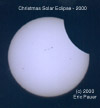
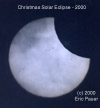
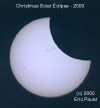
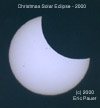
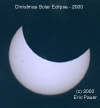
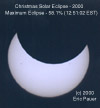
Webcast/Eclipse Report
Overall this eclipse went very well for me. Interestingly, this was my first partial solar eclipse. Previously, I have experienced the annular eclipse in 1994 (Manchester, New Hampshire, USA) and total solar eclipses in 1998 (Aruba) and 1999 (Hungary) (follow links to for details on these). First of all, here in southern New Hampshire, we were fortunate to have mostly clear (95%+) clear skies, with just a couple very widely scattered clouds. That's not the typical December day for this area. I did, however, have to contend with a cold, windy day with a 11° F (-12° C) temperature, with wind chills around 0° F (-18° C). Believe it or not, I was so happy for the clear skies and eclipse that I did not notice the cold. But some of my equipment succumbed to the cold (see below). I would like to thank my neighbor and fellow amateur astronomer Mike Quinn for allowing me to use his yard, telephone, and electricity. The trees surrounding my yard are too tall to provide the unobstructed view of the sun during late December. Mike's front yard has a small hill with a nice view to the south above the trees where I could set up. We did run 100 feet (30 meters) of phone line and power cord from his house. Thanks Mike!
My equipment included my Celestron 5" Schmidt-Cassegrain Telescope (SCT) with Canon EOS Rebel G camera, loaded with Fuji Superia Reala color print film (ISO 100). The SCT was mounted on a clock-driven equatorial mount. I replaced the stock counterweight that came with the mount with my Sony Digital8 DCR-TRV720 camcorder. Using this setup, I was able to keep both the SCT and camcorder aimed at the eclipsed sun on a single mount. I also used a 35 mm automatic Pentax camera to take a wide (50 mm) angle multiexposure photo (results TBD) every 25 minutes during the eclipse.
For the webcast, I planned to upload new images via 56K modem every 3 minutes, which is what happened in the beginning. Folks may have noticed that I briefly (at times) showed a view of the equipment/Mike/myself instead of the eclipse closeups, which was intentional, for a chance of pace. As the laptop got colder, despite being on AC power, it appeared to slow down, and the interval between new images grew to over 5 minutes with no changes in the webcast settings. Late in the webcast, I did notice the count down (in seconds) decrease at a slower than expected rate. I also think that the load on my ISP's server (Bit-Net) slowed down my image ftp uploads as over 40,000 combined hits occurred during the webcast on my 2000 Christmas Eclipse pages. Thanks for your interest! The 9-volt battery in the Snappy video capture unit also failed due to the cold, which I quickly replaced with a fresh, warm one. The batteries in my Canon EOS camera also died shortly after maximum eclipse. The camera needed to warm up inside Mike's house, and then it worked. Clearly, the cold was a factor to contend with.
I have already received over a hundred emails of appreciation from folks who "tuned" in, from all over the United States and the world. It is nice to get that kind of feedback. If you get a chance, email me (Eric Pauer) a quick note, letting me know how the webcast worked for you. My goal was to share the eclipse experience who could not otherwise "see" it, because of the weather, their geographical location, or their personal plans. After all, the eclipse was on Christmas Day!
Eclipse Photographs
During the eclipse, in addition to the live webcast, I took photographs using my SCT in prime focus (1250 mm focal length (f/10)), equipped with a Roger Tuthill Solar Skreen® Filter. All exposures were 1/125 second with the equatorial clock drive running. I will be adding photos taken after maximum eclipse when my second roll of film is processed (hopefully in a couple of days).
Note the numerous sunspots, including a nice grouping near the center of the sun's disk. Also, I managed to capture the eclipsed sun with some thin clouds, for a nice effect in the second photo below.






I videotaped the entire eclipse. From the tapes, I captured 40 video stills, about 5 minutes apart. I aligned the images using Adobe Photoshop and then created an animated GIF. A small thumbnail version (72K) is shown below. A larger verison (581K) can be viewed by clicking on the thumbnail version.
CLICK HERE for the Live
Webcast (close up view of eclipsed sun)
CLICK HERE for the Webcast
Information Page
You are visitor number
Please send comments about this page to Eric
Pauer. This page was last updated on 29 Jan 2001.